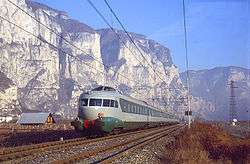FS Class ETR 300
| FS Class ETR 300 | |
|---|---|
 | |
| In service | 1953–1988 |
| Manufacturer | Breda (now AnsaldoBreda) |
| Constructed | 1952 – c. 1958/59 |
| Entered service | 1953–1959 |
| Number built | 3 trainsets |
| Formation | Seven-car trainset, including two power cars, at front and rear |
| Fleet numbers | (ETR-) 301–303 |
| Capacity | 190 |
| Operator(s) | Ferrovie dello Stato (FS) |
| Specifications | |
| Maximum speed | 200 km/h (124 mph) |
| Electric system(s) | 3 kV DC Overhead catenary |
| Current collection method | Pantograph |
| Track gauge | 1,435 mm (4 ft 8 1⁄2 in) standard gauge |
The ETR 300, also known as "Settebello-type" for its use on the former Settebello train service, is a type of Italian fast electric multiple unit (EMU) trainset formerly operated by Ferrovie dello Stato (Italian State Railways).[1] The letters ETR stood for elettrotreno rapido (Italian for high-speed electric train). Thanks to its aerodynamically low-drag profile, it boasted a maximum speed of 200 km/h (120 mph), with a power output of 2600 kW. Manufactured for FS by Breda, a total of only three trainsets were built, numbered ETR 301–303.[2]
Following development of the design that had begun in 1947, the first ETR 300-series unit began making test runs in September 1952. The first completed trainset, numbered ETR 301, was delivered to FS on 21 November 1952. After the delivery of the second set, number 302, the ETR 300-series trains entered regular service between Milan and Rome on 30 March 1953, on the new Settebello service.[2] The third and final set, ETR 303, entered service in 1959.[2]
Each EMU trainset had seven cars and seating for 190. In 1970, they were upgraded with more powerful motors, shortening the time it took for the Milan–Rome run. The TEE Settebello was discontinued in 1984,[3] and the ETR 300 series was removed from service on that route (Milan–Rome).[2] They remained in service elsewhere until 1988, when they were permanently retired. In 1998, two of the three trainsets were scrapped, leaving only number ETR 302 surviving, and used for occasional display or private hire.[2] The train still survives, but has been heavily vandalized with broken parts and grafiti, and is also slowly rusting away.[4]
References
- ↑ Nock, O.S. (1978). "The Settebello: speed and luxury", in World Atlas of Railways, pp. 118–119. New York: Mayflower Books (original publisher: Artists House, London, UK). ISBN 0-8317-9500-X.
- 1 2 3 4 5 Innocenti, Marco (20 November 2008). "21 novembre 1952: debutta il Settebello" [21 November 1952: The debut of the Settebello]. Il Sole 24 Ore (in Italian). Milan, Italy. Retrieved 26 February 2013.
- ↑ "Summer services, 1984" (changes taking effect). Thomas Cook Continental Timetable (May 1–June 2, 1984 edition), p. 64; also pp. 65–66 Peterborough, UK: Thomas Cook Publishing.
- ↑ Giampaolo Grilli (2016-04-08), ETR 302 SETTEBELLO - 2016_04_07, retrieved 2016-11-21
External links
![]() Media related to ETR 300 at Wikimedia Commons
Media related to ETR 300 at Wikimedia Commons